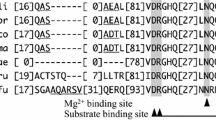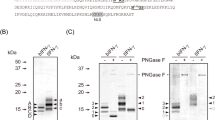Abstract
Cellulases catalyze the hydrolysis of cellulose which are mainly three types: endoglucanases, cellobiohydrolases and β-glucosidases. It can be used in converting cellulosic biomass to glucose that can be used in different applications such as production of fuel ethanol, animal feed, waste water treatment and in brewing industry. In this paper, we cloned a 1380-bp endoglucanase I (EG I) gene from mycelium of filamentous fungus Trichoderma viride strain AS 3.3711 using PCR-based exon splicing methods, and expressed the recombinant EG I mature peptide protein in both silkworm BmN cell line and silkworm larvae with a newly established Bac-to-Bac/BmNPV mutant baculovirus expression system, which lacks the virus-encoded chitinase (chiA) and cathepsin (v-cath) genes of Bombyx mori nucleopolyhedrovirus (BmNPV). An around 49-kDa protein was visualized after mBacmid/BmNPV/EG I infection, and the maximum expression in silkworm larvae was at 84 h post-infection. The ANOVA showed that the enzymes from recombinant baculoviruses infected silkworms exhibited significant maximum enzyme activity at the environmental condition of pH 7.0 and temperature 50°C. It was stable at pH range from 5.0 to 10.0 and at temperature range from 50 to 60°C, and increased 24.71 and 22.84% compared with that from wild baculoviruses infected silkworms and normal silkworms, respectively. The availability of large quantities of EG I that the silkworm provides maybe greatly facilitate the future research and the potential application in industries.


Similar content being viewed by others
References
Guo R, Ding M, Zhang SL, Xu GJ, Zhao FK (2008) Molecular cloning and characterization of two novel cellulase genes from the mollusc Ampullaria crossean. J Comp Physiol [B] 178:209–215
Wei YD, Lee KS, Gui ZZ, Yoon HJ, Kim I, Zhang GZ, Guo X, Sohn HD, Jin BR (2006) Molecular cloning, expression, and enzymatic activity of a novel endogenous cellulase from the mulberry longicorn beetle, Apriona germari. Comp Biochem Physiol B Biochem Mol Biol 145:220–229
Kim KC, Yoo SS, Oh YA, Kim SJ (2003) Isolation and characteristics of Trichoderma harzianum FJ1 producing cellulases and xylanase. J Microbiol Biotechnol 13:1–8
Li W, Huan X, Zhou Y, Ma Q, Chen Y (2009) Simultaneous cloning and expression of two cellulase genes from Bacillus subtilis newly isolated from Golden Takin (Budorcas taxicolor Bedfordi). Biochem Biophys Res Commun 383:397–400
Beguin P, Aubert JP (1994) The biological degradation of cellulose. FEMS Microbiol Rev 13:25–58
Miettinen-Oinonen A, Suominen P (2002) Enhanced production of Trichoderma reesei endoglucanases and use of the new cellulase preparations in producing the stonewashed effect on denim fabric. Appl Environ Microbiol 68:3956–3964
Penttila M, Lehtovaara P, Nevalainen H, Bhikhabhai R, Knowles J (1986) Homology between cellulase genes of Trichoderma reesei: complete nucleotide sequence of the endoglucanase I gene. Gene 45:253–263
Tomme P, Van Tilbeurgh H, Pettersson G, Van Damme J, Vandekerckhove J, Knowles J, Teeri T, Claeyssens M (1988) Studies of the cellulolytic system of Trichoderma reesei QM 9414. Analysis of domain function in two cellobiohydrolases by limited proteolysis. Eur J Biochem 170:575–581
Murashima K, Nishimura T, Nakamura Y, Koga J, Moriya T, Sumida N, Yaguchi T, Kono T (2002) Purification and characterization of new endo-1, 4-β-d-glucanses from Rhizopus oryzae. Enzyme Microb Technol 30:319–326
Saito K, Kawamura Y, Oda Y (2003) Role of the pectinolytic enzyme in the lactic acid fermentation of potato pulp by Rhizopus oryzae. J Ind Microbiol Biotechnol 30:440–444
Miyajima A, Schreurs J, Otsu K, Kondo A, Arai K, Maeda S (1987) Use of the silkworm, Bombyx mori, and an insect baculovirus vector for high-level expression and secretion of biologically active mouse interleukin-3. Gene 58:273–281
Wang Z, Zha X, He N, Xiang Z, Xia Q (2009) Molecular cloning and expression analysis of Bmrbp1, the Bombyx mori homologue of the Drosophila gene rbp1. Mol Biol Rep. doi:10.1007/s11033-009-9768-z
Nie Z, Lv Z, Qian J, Chen J, Li S, Sheng Q, Wang D, Shen H, Yu W, Wu X, Zhang Y (2009) Molecular cloning and expression characterization of translationally controlled tumor protein in silkworm pupae. Mol Biol Rep. doi:10.1007/s11033-009-9787-9
Wen H, Lan X, Zhang Y, Zhao T, Wang Y, Kajiura Z, Nakagaki M (2009) Transgenicsilkworms (Bombyx mori) produce recombinant spider dragline silk in cocoons. Mol Biol Rep. doi:10.1007/s11033-009-9615-2
Lu FH, Tang SM, Shen XJ, Wang N, Zhao QL, Zhang GZ, Guo XJ (2010) Molecular cloning and characterization of hatching enzyme-like gene in the silkworm, Bombyx mori. Mol Biol Rep 37(3):1175–1182
Motohashi T, Shimojima T, Fukagawa T, Maenaka K, Park EY (2005) Efficient large-scale protein production of larvae and pupae of silkworm by Bombyx mori nuclear polyhedrosis virus bacmid system. Biochem Biophys Res Commun 326:564–569
Miao YG, Zhang YS, Nakagaki K, Zhao TF, Zhao AC, Meng Y, Nakagaki M, Park EY, Maenaka K (2006) Expression of spider flagelliform silk protein in Bombyx mori cell line by a novel Bac-to-Bac/BmNPV baculovirus expression system. Appl Microbiol Biotechnol 71(2):192–199
Miao YG, Zhao AC, Zhang YS, Nakagaki K, Meng Y, Zhao TF, Nakagaki M (2006) Silkworm, Bombyx mori larvae expressed the spider silk protein through a novel Bac-to-Bac/BmNPV baculovirus. J Appl Entomol 130(5):297–301
Lee KS, Je YH, Woo SD, Sohn HD, Jin BR (2006) Production of a cellulase in silkworm larvae using a recombinant Bombyx mori nucleopolyhedrovirus lacking the virus-encoded chitinase and cathepsin genes. Biotechnol Lett 28:645–650
Aristidou A, Penttila M (2000) Metabolic engineering applications to renewable resource utilization. Curr Opin Biotechnol 11:187–198
Jeffries TW, Jin YS (2000) Ethanol and thermotolerance in the bioconversion of xylose by yeasts. Adv Appl Microbiol 47:221–268
Zaldivar J, Nielsen J, Olsson L (2001) Fuel ethanol production from lignocellulose: a challenge for metabolic engineering and process integration. Appl Microbiol Biotechnol 56:17–34
Tomme P, Warren RA, Gilkes NR (1995) Cellulose hydrolysis by bacteria and fungi. Adv Microb Physiol 37:1–81
Alam MZ, Muyibi SA, Wahid R (2008) Statistical optimization of process conditions for cellulase production by liquid state bioconversion of domestic wastewater sludge. Bioresour Technol 99:4709–4716
Chand P, Aruna A, Maqsood AM, Rao LV (2005) Novel mutation method for increased cellulase production. J Appl Microbiol 98:318–323
Latifian M, Hamidi-Esfahani Z, Barzegar M (2007) Evaluation of culture conditions for cellulase production by two Trichoderma reesei mutants under solid-state fermentation conditions. Bioresour Technol 98:3634–3637
Singhania RR, Sukumaran RK, Pandey A (2007) Improved cellulase production by Trichoderma reesei RUT C30 under SSF through process optimization. Appl Biochem Biotechnol 142:60–70
Murray PG, Collins CM, Grassick A, Tuohy MG (2003) Molecular cloning, transcriptional, and expression analysis of the first cellulase gene (cbh2), encoding cellobiohydrolase II, from the moderately thermophilic fungus Talaromyces emersonii and structure prediction of the gene product. Biochem Biophys Res Commun 301:280–286
Saloheimo M, Nakari-Setala T, Tenkanen M, Penttila M (1997) cDNA cloning of a Trichoderma reesei cellulase and demonstration of endoglucanase activity by expression in yeast. Eur J Biochem 249:584–591
Tang B, Pan H, Zhang Q, Ding L (2009) Cloning and expression of cellulase gene EG1 from Rhizopus stolonifer var. reflexus TP-02 in Escherichia coli. Bioresour Technol. doi:10.1016/j.biortech.2009.06.091
Wang TH, Liu T, Wu ZH, Liu SL, Lu Y, Qu YB (2004) Novel cellulase profile of Trichoderma reesei strains constructed by cbh1 gene replacement with eg3 gene expression cassette. Acta Biochim Biophys Sin (Shanghai) 36:667–672
Jeefrey LC, Charles SC (1996) Insect cell expression technology. In: Jeefrey LC, Charles SC (eds) Protein engineering principles and practice. Wiley-Liss Press, Wiley, New York. Chapter 7, pp 183–218
Maeda S (1994) Expression of foreign genes in insect cells using baculovirus vectors. In: Maramorosch K, McIntosh AH (eds) Insect cell biotechnology. CRC Press, Boca Raton, FL, pp 1–31
Choudary PV, Kamita SG, Maeda S (1995) Expression of foreign genes in Bombyx mori larvae using baculovirus vectors. In: Richardson CD (ed) Methods in molecular biology. Baculovirus expression protocols, vol 39. Humana, New Jersey
Liu JM, David WC, Ip DT, Li XH, Li GL, Wu XF, Yue WF, Zhang CX, Miao YG (2009) High-level expression of orange fluorescent protein in the silkworm larvae by the Bac-to-Bac system. Mol Biol Rep 36(2):329–335
Zhang Y, Hu J, Miao Y, Zhao A, Zhao T, Wu D, Liang L, Miikura A, Shiomi K, Kajiura Z, Nakagaki M (2008) Expression of EGFP-spider dragline silk fusion protein in BmN cells and larvae of silkworm showed the solubility is primary limit for dragline proteins yield. Mol Biol Rep 35(3):329–335
Acknowledgements
The work was supported by the National Basic Research Program of China under grand No. 2005CB121003 and the Hi-Tech Research and Development Program of China (No. 2008AA10Z132 and No. 2006AA10A119).
Author information
Authors and Affiliations
Corresponding author
Electronic supplementary material
Below is the link to the electronic supplementary material.
Rights and permissions
About this article
Cite this article
Li, Xh., Wang, D., Zhou, F. et al. Cloning and expression of a cellulase gene in the silkworm, Bombyx mori by improved Bac-to-Bac/BmNPV baculovirus expression system. Mol Biol Rep 37, 3721–3728 (2010). https://doi.org/10.1007/s11033-010-0025-2
Received:
Accepted:
Published:
Issue Date:
DOI: https://doi.org/10.1007/s11033-010-0025-2




